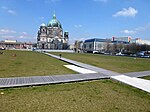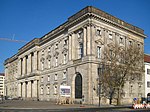Cölln
1230s establishments in the Holy Roman Empire1237 establishments in EuropeHistory of BerlinMittePopulated places established in the 13th century ... and 1 more
Zones of Berlin

Cölln (German: [ˈkœln]) was the twin city of Old Berlin (Altberlin) from the 13th century to the 18th century. Cölln was located on the Fisher Island section of Spree Island, opposite Altberlin on the western bank of the River Spree, until the cities were merged by Frederick I of Prussia to form Berlin in 1710. Today, the former site of Cölln is the historic core of the modern Mitte locality of the Berlin-Mitte borough in central Berlin.
Excerpt from the Wikipedia article Cölln (License: CC BY-SA 3.0, Authors, Images).Cölln
Schloßplatz, Berlin Mitte
Geographical coordinates (GPS) Address Nearby Places Show on map
Geographical coordinates (GPS)
| Latitude | Longitude |
|---|---|
| N 52.517222222222 ° | E 13.402777777778 ° |
Address
Berliner Schloss (Humboldt Forum)
Schloßplatz
10178 Berlin, Mitte
Germany
Open on Google Maps










